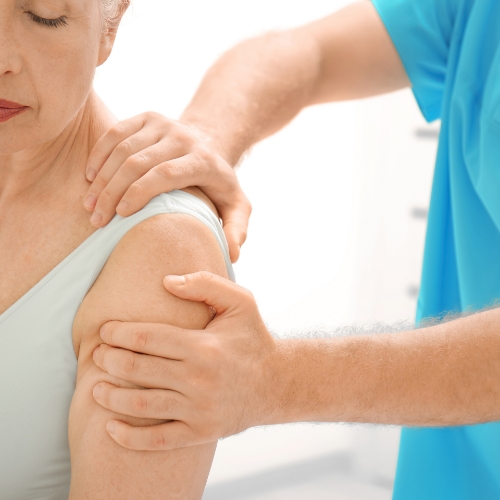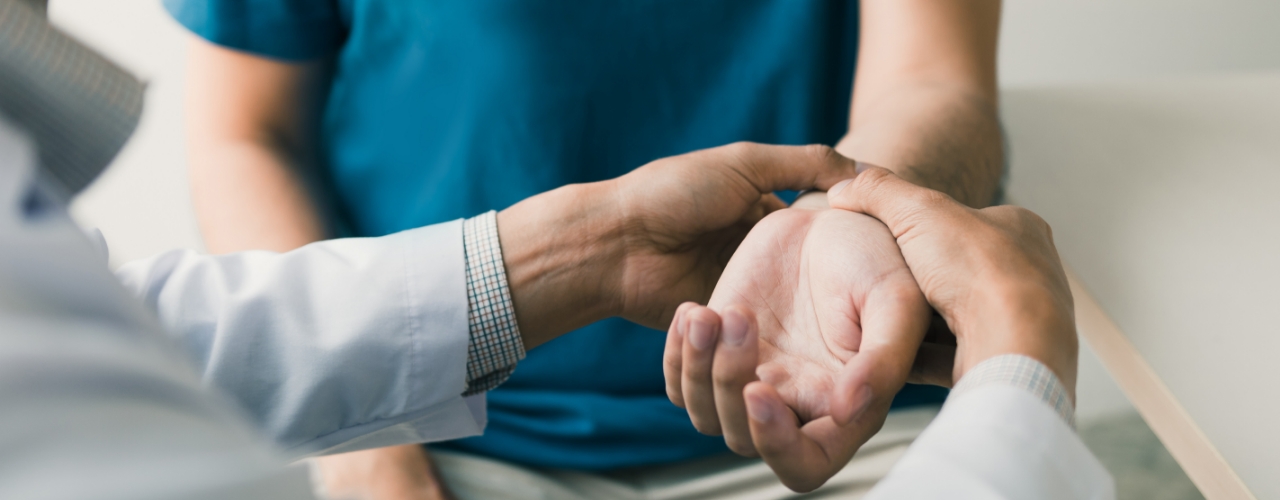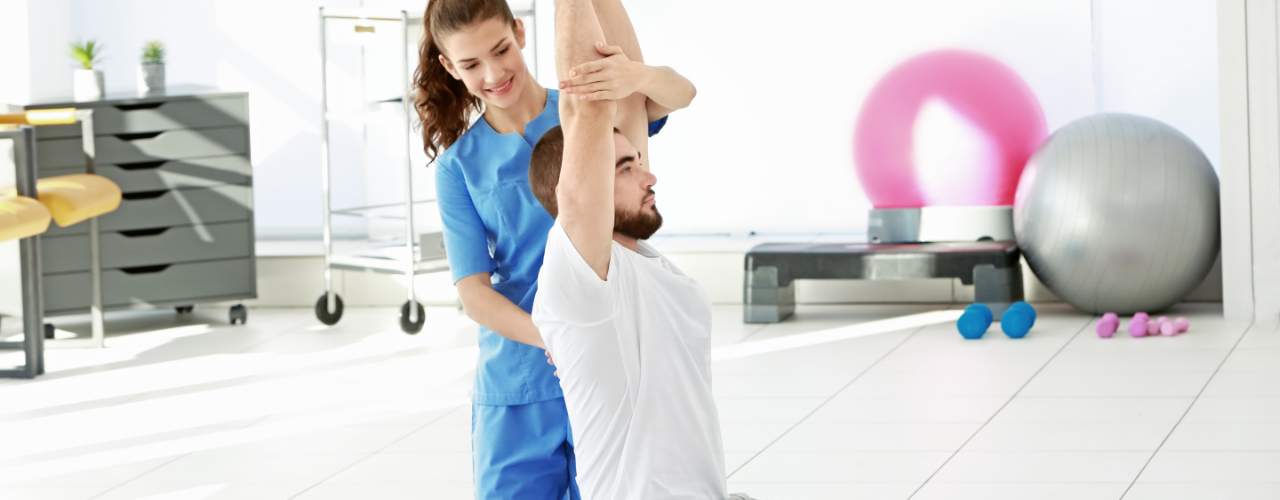Relieve Your Shoulder Pains with Our PT Treatments

Shoulder pain can present itself in many ways. Maybe you feel pain in your shoulder when you’re trying to get into a comfortable sleeping position, maybe you notice it when you reach your top cabinet to grab a glass or during sports and in more demanding work activities. However your shoulder pain may present itself, it’s no secret that it physically limits your life.
The shoulder is one of the most common joints in the body which can develop pain. One reason for this vulnerability is the amount of potential motion in the shoulder. It has more movement compared to any other joint in the body. To allow for this wide range of movement the shoulder must rely on an intricate muscle and ligament system along with four interacting joint systems. This relates directly to the shoulder, shoulder blade, and upper back/ribs. Because the functional performance of the shoulder relies extensively on muscle, the potential for developing muscle imbalances is quite strong and this is the primary reason for the many potential problems related to sports, repetitive motion, and postural strain. In addition, the arm is part of our protective mechanism, so any fall will be “broken” with our arm reaching out.
Full Potential Physical Therapy in Holland, MI is your source for solving even the most difficult problems. Schedule a free consultation to see what we can do for you.
COMMON SHOULDER PROBLEMS
The number of reasons why shoulder pain may develop is vast. However, some of the most common causes include:
Shoulder Impingement
The most common problem in the shoulder is diagnosed as shoulder impingement syndrome. Pain is usually in the front of the shoulder and down into the upper arm. Pain will increase as you raise the arm, especially at about midrange. If you do not do something about it, you can develop tendonitis or progressively more pain and/or loss of motion.
Tendinitis/Bursitis
Tendonitis is an inflammation of the tendon specific to the shoulder called the rotator cuff tendons. This is a more slow-to-heal condition and requires one to protect the shoulder from further damage by avoiding the offending activity. Ignoring your shoulder pain as you continue to use it, can lead you to more limited and painful movement to the point of developing a frozen shoulder.
Frozen Shoulder
A frozen shoulder or adhesive capsulitis as it is medically referred can occur from not acting to avoid the effects of impingement and tendonitis. Also, it can occur after trauma from a fracture or fall or surgery with the arm immobilized. At times, there was no obvious cause, the arm just gets tight and goes through various phases of pain and limited motion. In this case, there is often long-standing unrecognized stress on the shoulder from poor posture and muscle imbalances.
Rotator Cuff Tears
This is where the tendon has undergone excessive stress over time, possibly having tendonitis without proper care and eventually leading to a tear. As well, it can occur from a fall or accident with a sudden force on the tendon. A tear often requires surgery to fix the problem and from there a comprehensive rehabilitation program to get the motion, strength and function back to normal. It usually requires the patient to be fully involved in their exercise program to get a good result.
Post-Surgery Rehabilitation
Post-surgery rehabilitation for shoulder injuries focuses on restoring strength, range of motion, and function. The program is tailored to the specific surgery and individual needs, often starting with gentle exercises and progressing as the shoulder heals. Physical therapy plays a crucial role in helping patients recover fully and safely after surgery.
Arthritis/ Osteoarthritis
Osteoarthritis (OA) of the shoulder joint is often the consequence of use, age and stress causing excessive wear. Arthritis is a graded diagnosis from mild to severe. The best help PT can offer is before the OA gets severe. Those who have severe arthritis and are of the right age range may need a shoulder replacement or surgery of some type to overcome the joint problem. Milder forms of OA can often be helped in PT with a program designed to restore motion and strength.
Labrum Tear
A labrum tear in the shoulder is an injury to the cartilage surrounding the shoulder socket, often caused by trauma or repetitive motion. Symptoms include pain, clicking or catching sensations, and shoulder instability.
Dislocation/Instability
Dislocation of the shoulder occurs when the head of the humerus pops out of place. This type of injury is extremely painful and unfortunately makes you more vulnerable to recurrence after the first dislocation occurs.
Sprains/Strains
Sprains and strains of the shoulder can occur from sudden or overuse injuries, resulting in damage to the ligaments, tendons, or muscles. Symptoms include pain, swelling, and limited range of motion.
Fractures
Shoulder fractures can occur from trauma or falls, leading to pain, swelling, and difficulty moving the arm. Treatment may involve immobilization, surgery to realign the bones, and rehabilitation to regain strength and mobility.
All the above diagnosis can be helped with PT especially if they do not delay care and allow the development of severe impingement, tendonitis or OA.
Full Potential Physical Therapy is equipped to help you with your shoulder problem, whether from an injury or post-surgical. If you have any questions about whether PT is right for you, get a free consultation with us, learn more about your options and get informed to make the right decision.
Physical Therapy Can Help
Whether your shoulder pain onset is recent from a fall, accident, or heavy use, or you have been coping with it for months to years, there is often a basis for the pain. Starting with a thorough exam to pinpoint the source is key to successful treatment.
Successful treatment works from pain control to establishing normal return of motion to finally strengthening and functional exercises. It often requires notable hands-on care to help regain motion which will transition into more exercise as the patient is more able to participate.
Ultimately what most people are looking for is performance, that your shoulder can deliver what you need when you need it as it relates to work, lifting, repetitive motion, or sports. This is where strength muscle balance and coordination are needed which is the final phase of getting better.
Because muscle plays a significant role in the shoulder to deliver performance, a patient has to be a willing participant in the process. Motion, strength, and muscle balance are the qualities that give a person the ability to get back to doing the things their life demands and enjoys.
Physical therapy and the shoulder go very well together since most functional recoveries will require following the appropriate steps to restore motion and build the necessary postural and shoulder strength. This is why nearly all shoulder injuries and surgeries will require some degree of rehabilitation since these steps will not usually happen on their own.
Related Case Studies
“When I started PT, I was unable to lift and utilize my left arm because of a shoulder injury. I was constantly in pain. Luke’s plan and support has helped me regain strength and mobility so I’m able to get back to my daily + fitness routines. I’m so thankful for Luke and Full Potential PT!”
“I wasn’t sure this was going to work for how bad my pain was- but I was proven wrong and I’m doing great.”
Find relief today
If your shoulder pain is limiting your life, contact Full Potential Physical Therapy in Holland, MI as soon as possible to secure your appointment. We will manage and treat your condition so you can comfortably get back to your daily life!
A Better Life is Only Four Steps Away
Physical therapy can be an unfamiliar experience for many. To orient new patients to the process, we have divided their rehab journey into four segments called “The Four Phases of Getting Better.” It is important to note that while there are four phases utilized over the course of your care, they are not totally separate. They move gradually toward greater strengthening and function, which is the end goal to return confidently to the life you desire to live.
1
Pain Relief
The first focus in getting better is pain relief. After your evaluation, your physical therapist will use hands-on techniques or manual therapy, light therapeutic exercise, and education on how to modify your activity and posture in order to give you more control over your pain. In this stage, modalities like ice, heat, myofascial release, electric stimulation and kinesiotape may be used.
2
Improve Mobility/Flexibility
The second step in this method is to improve mobility and flexibility. Your therapist will design a progressive program of range of motion and light stretching to restore mobility and reduce pain.
3
Improve Strength/Control
In the third step of this method, muscle weakness will be addressed to help you maintain the gains and momentum you achieve through phases one and two. A thorough strengthening process is the step that gives results that last, and this will prepare you for more functional training – the final step.
4
Functional Training
Now that your pain is resolved and you have the necessary mobility and strength, your program can be advanced into functional training. Whether you are returning to work, returning to life after post-op rehabilitation, getting back into recreation or sports, or simply returning to the activities of daily life, this step helps ensure your success after graduation and empowers you to be confident in your abilities again.

Reach Your Full Potential & Live Pain-Free!
Book A Free Consultation
Book a Free Consultation Today to Find Out How Physical Therapy Can Help You Find Relief!
request an appointment
Reach Your Full Potential and Live Life Pain-Free! Request an Appointment to Get Started Today!






